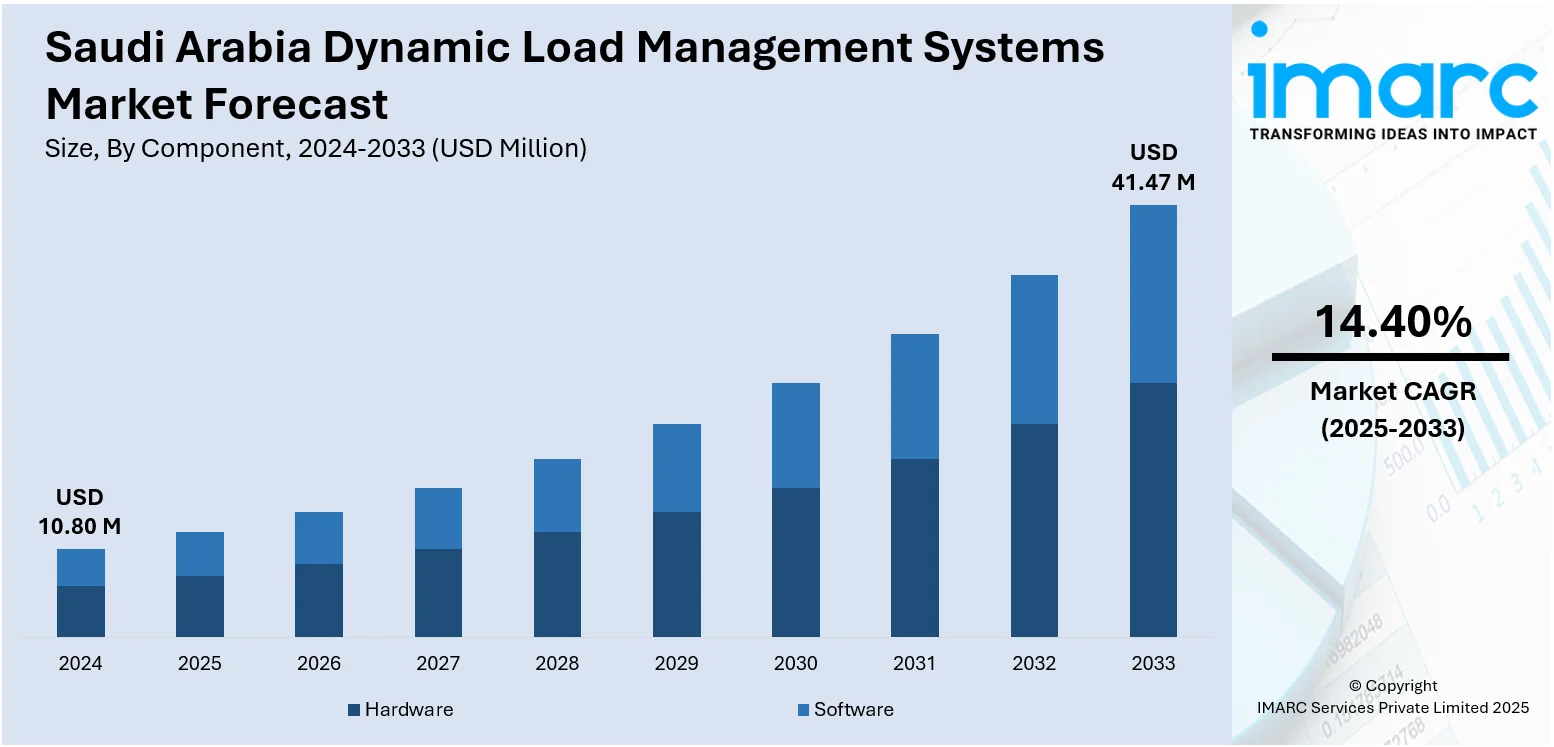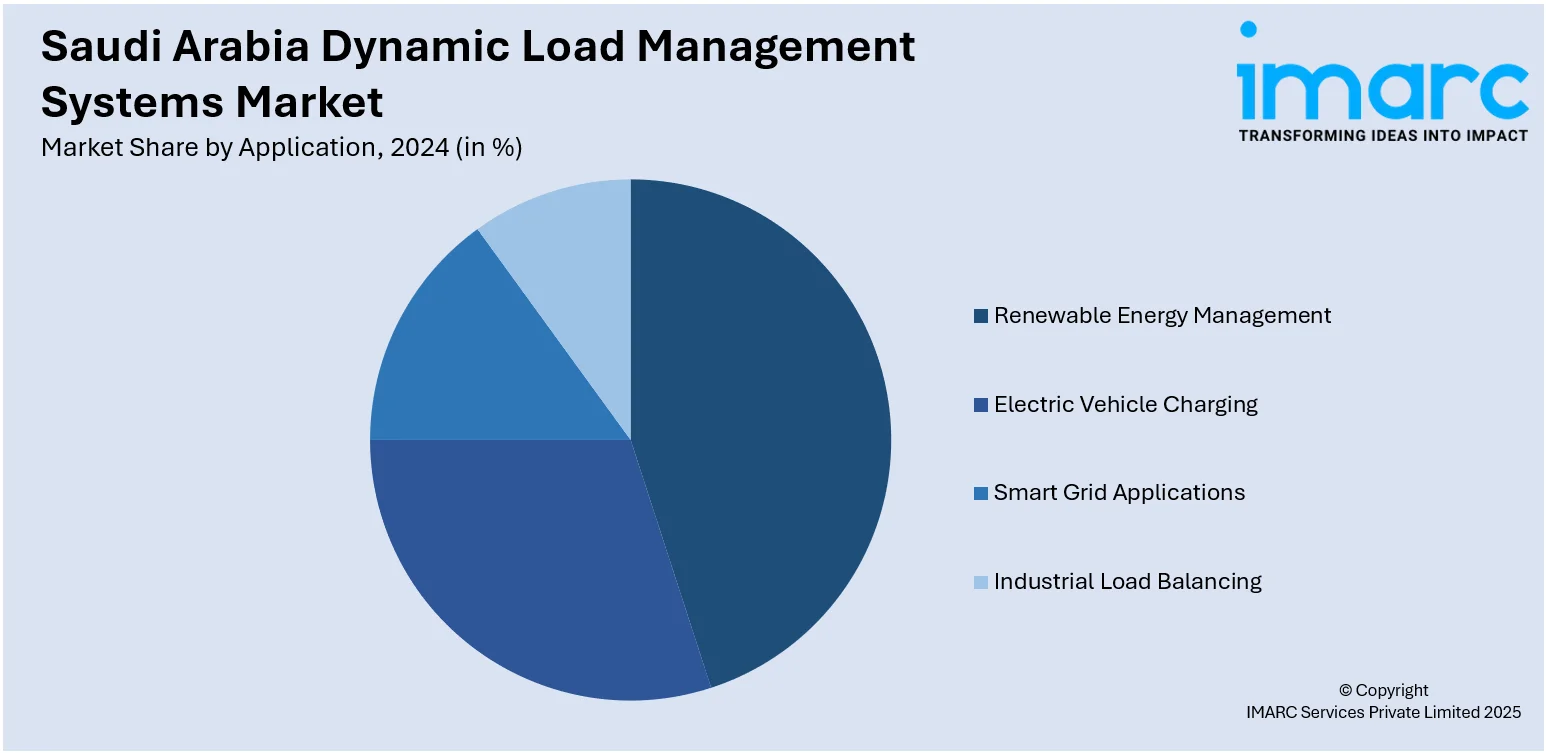
Saudi Arabia Dynamic Load Management Systems Market Size, Share, Trends and Forecast by Component, Application, Technology, Deployment Mode, End User, and Region, 2025-2033
Saudi Arabia Dynamic Load Management Systems Market Overview:
The Saudi Arabia dynamic load management systems market size reached USD 10.80 Million in 2024. Looking forward, IMARC Group expects the market to reach USD 41.47 Million by 2033, exhibiting a growth rate (CAGR) of 14.40% during 2025-2033. The market is expanding due to the growing demand for energy storage solutions and smart infrastructure. In addition, a strong focus on grid efficiency, renewable energy integration, and predictive maintenance continues to support Saudi Arabia dynamic load management systems market share across various industrial sectors.
|
Report Attribute
|
Key Statistics
|
|---|---|
|
Base Year
|
2024
|
|
Forecast Years
|
2025-2033
|
|
Historical Years
|
2019-2024
|
| Market Size in 2024 | USD 10.80 Million |
| Market Forecast in 2033 | USD 41.47 Million |
| Market Growth Rate 2025-2033 | 14.40% |
Saudi Arabia Dynamic Load Management Systems Market Trends:
Advancements in Grid Efficiency and Flexibility
Saudi Arabia load management systems market is growing substantially due to the requirement for improved grid stability and energy efficiency. As renewable energy use surges and power demand varies, energy storage and intelligent management systems come into play. In line with this, in January 2025, the Saudi Electricity Company commissioned BYD contracts for 12.5 GWh of battery storage at five locations. This was a huge leap towards enhancing the performance of the country's grid by facilitating dynamic load management. Battery energy storage systems enable load shifting, frequency response, and voltage control, contributing to grid stability during peak demand hours and maintaining reliable delivery of energy. In addition, the systems also enable renewable energy integration, which is typically plagued by variability. Saudi Arabia is optimizing its energy efficiency as well as emerging as a leader in smart grid technologies by integrating such advanced energy storage systems. The success of this venture is a testament to the nation's ongoing commitment to updating its energy infrastructure in line with Vision 2030. As energy storage technology, including BYD batteries, continues to advance, they will be instrumental in driving the dynamic load management systems market to expand in the region.

To get more information on this market, Request Sample
Real-Time Load Monitoring for Structural Integrity
The need for predictive maintenance and real-time monitoring is becoming a central trend in Saudi Arabia's infrastructure sector, particularly for critical assets in industrial and energy applications. With the increasing complexity of systems and growing demands on infrastructure, ensuring the reliability and longevity of assets is paramount. For instance, in May 2025, InterBolt introduced dynamic load monitoring to its intelligent bolting system, allowing for real-time measurement of cyclic loads in operational assets. Furthermore, this advancement in load monitoring is critical for improving structural reliability in large-scale operations. Providing continuous, high-frequency data on bolt loads enables operators to anticipate potential failures, perform maintenance proactively, and prevent downtime. Apart from that, this technology enhances operational safety and supports better decision-making through data-driven insights. As industries in Saudi Arabia seek to optimize asset performance and minimize operational disruptions, technologies like InterBolt's intelligent bolting system will be crucial. The integration of real-time monitoring into dynamic load management systems enhances asset management practices. Therefore, this trend is driving innovation in Saudi Arabia dynamic load management system market growth.
Saudi Arabia Dynamic Load Management Systems Market Segmentation:
IMARC Group provides an analysis of the key trends in each segment of the market, along with forecasts at the country and regional level for 2025-2033. Our report has categorized the market based on component, application, technology, deployment mode, and end user.
Component Insights:
- Hardware
- Software
The report has provided a detailed breakup and analysis of the market based on the component. This includes hardware and software.
Application Insights:

- Renewable Energy Management
- Electric Vehicle Charging
- Smart Grid Applications
- Industrial Load Balancing
The report has provided a detailed breakup and analysis of the market based on the application. This includes renewable energy management, electric vehicle charging, smart grid applications, and industrial load balancing.
Technology Insights:
- Cloud-based Solutions
- IoT-enabled Devices
- Artificial Intelligence Integration
The report has provided a detailed breakup and analysis of the market based on the technology. This includes cloud-based solutions, IoT-enabled devices, and artificial intelligence integration.
Deployment Mode Insights:
- On-premises
- Cloud-based Deployment
- Hybrid Deployment
The report has provided a detailed breakup and analysis of the market based on the deployment mode. This includes on-premises, cloud-based deployment, and hybrid deployment.
End User Insights:
- Residential
- Commercial
- Industrial
The report has provided a detailed breakup and analysis of the market based on the end user. This includes residential, commercial, and industrial.
Regional Insights:
- Northern and Central Region
- Western Region
- Eastern Region
- Southern Region
The report has also provided a comprehensive analysis of all the major regional markets, which include Northern and Central region, Western region, Eastern region, and Southern region.
Competitive Landscape:
The market research report has also provided a comprehensive analysis of the competitive landscape. Competitive analysis such as market structure, key player positioning, top winning strategies, competitive dashboard, and company evaluation quadrant has been covered in the report. Also, detailed profiles of all major companies have been provided.
Saudi Arabia Dynamic Load Management Systems Market News:
- June 2025: Hubject, Heliox, Accelera by Cummins, and Blue Bird launched the first ISO 15118-20 compliant V2G solution. This collaboration enhanced dynamic load management systems by enabling bi-directional energy transfer, optimizing grid resilience, and improving energy efficiency, driving growth in the EV and energy sectors.
- May 2025: Kitu Systems launched its Expedition CMS, enhancing EV charge management with advanced load management and integration capabilities. The platform’s interoperability with various EVSE brands and utility systems bolstered Saudi Arabia’s dynamic load management systems market, driving efficiency in grid and energy use.
Saudi Arabia Dynamic Load Management Systems Market Report Coverage:
| Report Features | Details |
|---|---|
| Base Year of the Analysis | 2024 |
| Historical Period | 2019-2024 |
| Forecast Period | 2025-2033 |
| Units | Million USD |
| Scope of the Report |
Exploration of Historical Trends and Market Outlook, Industry Catalysts and Challenges, Segment-Wise Historical and Future Market Assessment:
|
| Components Covered | Hardware, Software |
| Applications Covered | Renewable Energy Management, Electric Vehicle Charging, Smart Grid Applications, Industrial Load Balancing |
| Technologies Covered | Cloud-based Solutions, IoT-enabled Devices, Artificial Intelligence Integration |
| Deployment Modes Covered | On-premises, Cloud-based Deployment, Hybrid Deployment |
| End Users Covered | Residential, Commercial, Industrial |
| Regions Covered | Northern and Central Region, Western Region, Eastern Region, Southern Region |
| Customization Scope | 10% Free Customization |
| Post-Sale Analyst Support | 10-12 Weeks |
| Delivery Format | PDF and Excel through Email (We can also provide the editable version of the report in PPT/Word format on special request) |
Key Questions Answered in This Report:
- How has the Saudi Arabia dynamic load management systems market performed so far and how will it perform in the coming years?
- What is the breakup of the Saudi Arabia dynamic load management systems market on the basis of component?
- What is the breakup of the Saudi Arabia dynamic load management systems market on the basis of application?
- What is the breakup of the Saudi Arabia dynamic load management systems market on the basis of technology?
- What is the breakup of the Saudi Arabia dynamic load management systems market on the basis of deployment mode?
- What is the breakup of the Saudi Arabia dynamic load management systems market on the basis of end user?
- What is the breakup of the Saudi Arabia dynamic load management systems market on the basis of region?
- What are the various stages in the value chain of the Saudi Arabia dynamic load management systems market?
- What are the key driving factors and challenges in the Saudi Arabia dynamic load management systems market?
- What is the structure of the Saudi Arabia dynamic load management systems market and who are the key players?
- What is the degree of competition in the Saudi Arabia dynamic load management systems market?
Key Benefits for Stakeholders:
- IMARC’s industry report offers a comprehensive quantitative analysis of various market segments, historical and current market trends, market forecasts, and dynamics of the Saudi Arabia dynamic load management systems market from 2019-2033.
- The research report provides the latest information on the market drivers, challenges, and opportunities in the Saudi Arabia dynamic load management systems market.
- Porter's five forces analysis assist stakeholders in assessing the impact of new entrants, competitive rivalry, supplier power, buyer power, and the threat of substitution. It helps stakeholders to analyze the level of competition within the Saudi Arabia dynamic load management systems industry and its attractiveness.
- Competitive landscape allows stakeholders to understand their competitive environment and provides an insight into the current positions of key players in the market.
Need more help?
- Speak to our experienced analysts for insights on the current market scenarios.
- Include additional segments and countries to customize the report as per your requirement.
- Gain an unparalleled competitive advantage in your domain by understanding how to utilize the report and positively impacting your operations and revenue.
- For further assistance, please connect with our analysts.
 Request Customization
Request Customization
 Speak to an Analyst
Speak to an Analyst
 Request Brochure
Request Brochure
 Inquire Before Buying
Inquire Before Buying




.webp)




.webp)












